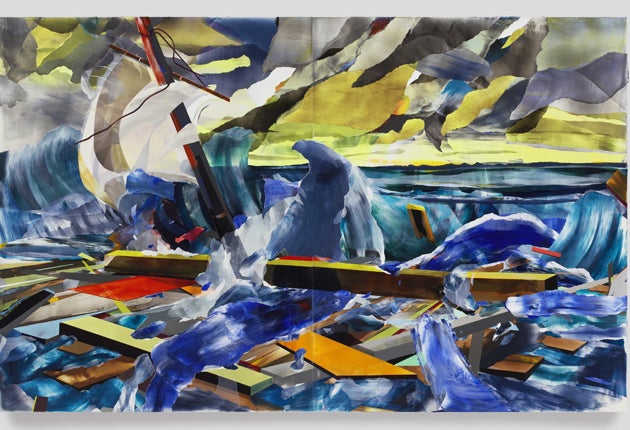Abstract America, Saatchi Gallery, London
The styles and strategies of the past 20 years have foundered on lack of originality, as this exhibition illustrates

Like nuclear deterrence, abstraction is an idea best used sparingly.
Start overapplying it and who knows where things will end? All art is an abstraction, but to describe certain kinds of art as abstract is to imply specific things about them – that they reject representation, that they set out to be autotelic, complete in themselves. Abstract is a serious word; in the mouth of the great American critic, Clement Greenberg, almost a religious one. It is not to be taken lightly.
So the distant whirr you hear as you walk into the Saatchi Gallery just now may be of Greenberg spinning in his grave. This is caused by a show called Abstract America, and it is strange. The Saatchi is a fine institution, adept at spotting trends, so I'd guess that the point of Abstract America is to suggest a return, among contemporary US artists, to those high-minded values Greenberg held dear. But the work on the gallery's walls is not Greenbergian, and neither, in most cases, is it abstract.
It is hard to know where to start, but Gallery 3 is as bad a place as any. This houses paintings by Kristin Baker, a thirtysomething New Yorker and self-confessed Formula One fan. Baker's taste for the track shows itself in a large and splashy acrylic called Washzert Suisse, which renders a speeding monocoque as fractured triangles. The feel is Futuristic – as you look at the picture, you hear, distant and garbled, Marinetti's taunt that a racing car is more beautiful than the Victory of Samothrace. Next to this work is another, The Raft of Perseus, which echoes Géricault's Raft of the Medusa. What is Baker doing with these old-hat references? He's playing games with myth, jostling for position in the great race of art history. You can't help feeling, though, that her Raft of Perseus might have been called Ship of Theseus – that it prompts (and, sadly, answers) the question, raised by that craft, of what is left when all originality is gone.
More to the point, Baker's work raises the question of what it is doing in a show called Abstract America. Her style, all planes and angles, is certainly not photorealist. But there is a difference between being abstracted and being abstract: abstraction, as I say, is a way of life, not a post-Post-modern gimmick. And this misrepresentation applies to most of the work in this misconceived show.
In what sense is Jonas Wood's faux-naive, faux-Hopper painting, Untitled (M.V. Landscape), abstraction? Or Matt Johnson's gnawed-apple sculpture, Malus Sieversii? Or Agathe Snow's appalling trio of junk-crucifixions, or Stephen G Rhodes's cubic cow? Far from helping us to understand these works, shoe-horning them into a show called Abstract America forces us to judge them by a set of rules which they are bound, by their non-abstract nature, to break. Those of you to whom "abstraction" signifies something great – Josef Albers, say, or Jackson Pollock or Barbara Hepworth – will find the sense of being hoodwinked so pronounced as to turn you against works you might otherwise have enjoyed.
So why, so untypically, has the Saatchi Gallery got it so wrong? I'd say that we are living through a genuine crisis in art, a real sense that the styles and strategies of the past 20 years have run out of steam. Artists, and especially young artists, need new answers, and they are looking for them in old places.
When Tomma Abts won the Turner Prize in 2006, sad old Greenbergians like myself wondered whether we might not be witnessing a return to the virtues of what Greenberg called – always in quotation marks – "purity".
The answer to that, alas, was no, or at least not wholly and not yet. There are artists in Abstract America who deserve to be there: Chris Martin's In Memory of James Brown "God- father of Soul" is a lovely picture, entirely absorbed in shape and form and bituminous shine; Mark Bradford's White Painting shows that there is life in Robert Ryman yet. But the artists in the Saatchi show to whom the word "abstract" might usefully be applied are few and far between, and you get no sense that they constitute a tendency or movement, far less a school. If Abstract America has anything going for it, it is that it makes this clear: that art at the moment has lost its way, and is flailing around for an answer.
Saatchi Gallery (020-7552 7888), to 30 Sep
Subscribe to Independent Premium to bookmark this article
Want to bookmark your favourite articles and stories to read or reference later? Start your Independent Premium subscription today.

Join our commenting forum
Join thought-provoking conversations, follow other Independent readers and see their replies